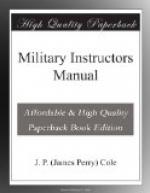Owing to the enemy gas sometimes causing bad after
effects, which are
intensified by subsequent exertion, the following
points should be
attended to:
(a) No man suffering
from the effects of gas, however slightly,
should
be allowed to walk to the dressing station.
(b) The clearing
of the trenches and dugouts should not be
carried
out by men who have been affected by the gas.
(c) After a gas
attack, troops in the front trenches should be
relieved
of all fatigue and carrying work for 24 hours by
sending
up working parties from companies in rear.
(d) Horses which
have been exposed to the gas should not be
worked
for 24 hours if it can be avoided.
3. CLEARING DUGOUTS AND OTHER SHELTERS:
It is essential that no dugout be entered after a gas attack event with box respirators or helmets adjusted, until it has been ascertained that it is free from gas. The only efficient method of clearing dugouts from gas is by thorough ventilation. The older method of spraying is not efficient.
An appreciable quantity of gas may be retained in the clothing of men exposed to gas attacks and also in bedding, coats, etc., left in shelters. Precaution should, therefore, be taken to air all clothing.
4. VENTILATION:
Natural Ventilation.—Unless a shelter has been thoroughly ventilated by artificial means, as described below, it must not be slept in or occupied without wearing respirators, until at least 12 hours after a gas attack. It must not be entered at all without respirators on for at least 3 hours. The above refers to cloud gas attacks. In the case of gas shell bombardments the times cannot be definitely stated, as they depend on the nature of the gas used and the severity of the bombardment. With lachrymatory gases the times after which shelters can be used without discomfort may be considerably longer than those mentioned above.
Ventilation by Fire.—All kinds of shelters can be efficiently and rapidly cleared of gas by the use of fires. Shelters with two openings are the easiest to ventilate and where possible, dugouts with only one entrance should have a second opening made, even a very small one, to assist in ventilation.
In dugouts provided with a single exit at the end of a short passage, the best results are obtained if the fire is placed in the center of the floor of the dugout and at a height of about 9 inches.
In dugouts provided with a single exit at the end of a long and nearly horizontal passage, the best results are obtained if the fire is placed about one-third of the distance from the inner end of the passage.
In dugouts provided with two or more exits, the fire should be placed at the inner end of one of the exit passages.
In general, 1 pound of dry wood per 200 cubic feet of air space is sufficient for clearance of any gas. The best fuel is split wood, but any fuel which does not smoulder or give off thick smoke can be used. The materials for the fire, e.g., the split wood, newspaper, and a small bottle of paraffine for lighting purposes, should be kept in a sand bag, enclosed in a biscuit tin provided with a lid. An improvised brazier should be kept ready for use.




